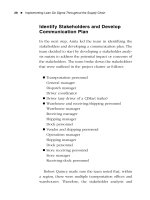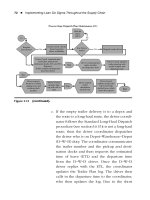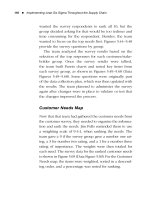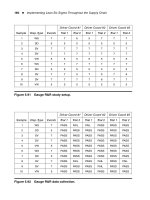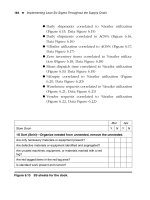Lean six sigma process improvement tools and techniques by donna summers chapter 22
Bạn đang xem bản rút gọn của tài liệu. Xem và tải ngay bản đầy đủ của tài liệu tại đây (23.72 KB, 7 trang )
Failure Modes and Effects
Analysis
Chapter 22
Lean Six Sigma: Process Improvement Tools and Techniques
Donna C. Summers
© 2011 Pearson Higher Education,
Upper Saddle River, NJ 07458. • All Rights Reserved.
Failure Modes and Effects
Analysis
• Failure Modes and Effects (FMEA)
– Critically examine the system
– Divide the system into its various components
– Examine each individual component
• Record the ways the component may fail
• Rate potential degree of hazard
– Examine all potential failures for each individual component and
decide what effect the failures may have
» Weakness: Human Error Component Missing
» See additional notes
Lean Six Sigma: Process Improvement Tools and Techniques
Donna C. Summers
© 2011 Pearson Higher Education,
Upper Saddle River, NJ 07458. • All Rights Reserved.
Failure Modes and Effects
Analysis
• Failure Modes and Effects Analysis
– Design FMEA’s
• used to verify that a product has been properly designed to
meet all of the customer’s requirements and that it can be
manufactured at a target rate, cost, and yield.
– Process FMEA’s
• used to assess the adequacy of a process in producing a
product.
Lean Six Sigma: Process Improvement Tools and Techniques
Donna C. Summers
© 2011 Pearson Higher Education,
Upper Saddle River, NJ 07458. • All Rights Reserved.
Failure Modes and Effects
Analysis
• What are Design FMEA’s used for?
– To capture the relationship between:
•
•
•
•
customer requirements and
how a product can fail to meet these requirements and
the effects of the failures and
the problems with the design that cause the failures.
– As a method to ensure that the design will
be changed and tested so that the failures
do not occur.
Lean Six Sigma: Process Improvement Tools and Techniques
Donna C. Summers
© 2011 Pearson Higher Education,
Upper Saddle River, NJ 07458. • All Rights Reserved.
Failure Modes and Effects
Analysis
• What are Process FMEA’s used for?
– To identify the process and product controls
that must be implemented to ensure that the
product can be produced within specification.
Lean Six Sigma: Process Improvement Tools and Techniques
Donna C. Summers
© 2011 Pearson Higher Education,
Upper Saddle River, NJ 07458. • All Rights Reserved.
Failure Modes and Effects
Analysis
• What are Process FMEA’s used for?
– To capture the relationship between
• each process step and
• the unacceptable process outputs that can be created at
each step and
• the effects of the unacceptable process outputs and
• the causes of the unacceptable outputs and
• how the unacceptable outputs will be either prevented or
detected in the event that they occur.
Lean Six Sigma: Process Improvement Tools and Techniques
Donna C. Summers
© 2011 Pearson Higher Education,
Upper Saddle River, NJ 07458. • All Rights Reserved.
Failure Modes and Effects
Analysis
• Steps to Create an FMEA
– Create a form similar to that shown in the chapter
– Study the system, process, or part
•
•
•
•
•
What are the potential failure modes?
What are the potential failure causes?
What are the potential failure consequences?
What are the existing controls?
Identify Risk Priority Code
– Severity
– Probability of Occurrence
• Analyze the document
Lean Six Sigma: Process Improvement Tools and Techniques
Donna C. Summers
© 2011 Pearson Higher Education,
Upper Saddle River, NJ 07458. • All Rights Reserved.


